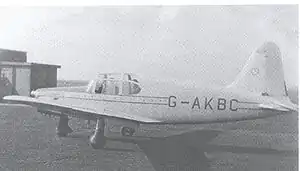Elliotts of Newbury Eon
The Elliotts of Newbury EoN or Elliotts EoN A.P.4 was a 1940s British four-seat touring monoplane aircraft built by Elliotts of Newbury.
| Newbury EoN | |
|---|---|
 | |
| Newbury Eon G-AKBC demonstrating at Barton Aerodrome Manchester in 1948 | |
| Role | Touring monoplane |
| Manufacturer | Elliotts of Newbury |
| Designer | Aviation and Engineering Products, Ltd[1] |
| First flight | 8 August 1947 |
| Retired | 1950 |
| Number built | 1 |
Development
Elliotts of Newbury were experienced wartime glider manufacturers but at the end of World War II decided to venture into the design and production of powered aircraft. The result was the EoN A.P.4 (more commonly called the Newbury Eon,[1] a wooden four-seat monoplane with a fixed tricycle landing gear. The design had been carried out by Aviation and Engineering Products Ltd of Feltham, Middlesex. The prototype Eon 1 registered G-AKBC powered by a 100 hp (75 kW) Blackburn Cirrus Minor engine first flew at Welford, Berkshire, on 8 August 1947.[2] After initial testing was completed, the prototype was modified to reflect the planned production version. The main changes were a new engine, a de Havilland Gipsy Major of 145 hp (108 kW), and a lengthened nose-wheel leg. The modified aircraft was redesignated the Eon 2.[2]
The company decided not enter production and it continued as a glider manufacturer. The sole completed Eon aircraft was used as a glider-tug to demonstrate the company's gliders. The aircraft met its end at Lympne airfield, Kent, on 14 April 1950,[2] when, with a glider attached the pilot started the aircraft by swinging the propeller with the aircraft's wheels not secured by chocks. The engine started, and the craft moved forward; the pilotless aircraft and the glider were damaged as the aircraft passed through a boundary hedge. The glider pilot had also abandoned his cockpit when he realised what was happening.[3][4]
Variants
- Eon 1
- Prototype with a 100 hp (75 kW) Blackburn Cirrus Minor piston engine.
- Eon 2
- Prototype re-engined with a 145 hp (108kW) de Havilland Gipsy Major engine.
Specifications (Eon 2)
Data from For Business and Pleasure[5]
General characteristics
- Crew: 1
- Capacity: 3 passengers
- Length: 25 ft 6 in (7.77 m)
- Wingspan: 37 ft 0 in (11.28 m)
- Height: 9 ft 9 in (2.97 m)
- Wing area: 173 sq ft (16.1 m2)
- Aspect ratio: 8:1
- Airfoil: NACA 2R.12
- Empty weight: 1,714 lb (777 kg)
- Max takeoff weight: 2,350 lb (1,066 kg)
- Powerplant: 1 × de Havilland Gipsy Major 10 four-cylinder inverted air-cooled piston engine, 145 hp (108 kW)
Performance
- Maximum speed: 136 mph (219 km/h, 118 kn)
- Cruise speed: 116 mph (187 km/h, 101 kn)
- Stall speed: 50 mph (80 km/h, 43 kn) (flaps down)
- Range: 350 mi (560 km, 300 nmi)
- Service ceiling: 13,400 ft (4,100 m)
- Rate of climb: 675 ft/min (3.43 m/s)
- Take-off run to 50 ft (15 m): 1,635 ft (498 m)
- Landing run from 50 ft (15 m): 1,500 ft (460 m)
References
| Wikimedia Commons has media related to Elliotts Newbury EoN. |
- Notes
- Flight p497
- Jackson 1974, p. 274
- Philpott Air Pictorial December 1969, p. 457.
- "Gliding News". Flight. Vol. LVII no. 2157. 27 April 1950. p. 535.
- Jerram Aeroplane Monthly August 1986, p. 441.
- Bibliography
- Jackson, A.J. (1974). British Civil Aircraft since 1919 - Volume 3. Putnam & Company Limited. ISBN 0-370-10014-X.
- Jerram, Mike (August 1986). "For Business and Pleasure—No 2: Newbury Eon". Aeroplane Monthly. Vol. 14 no. 8. pp. 438–441. ISSN 0143-7240.
- Philpott, Brian (December 1969). "Newbury Eon". Air Pictorial. Vol. 31 no. 12. pp. 456–457.
- The Illustrated Encyclopedia of Aircraft (Part Work 1982–1985), 1985, Orbis Publishing
- "Progress with the Newbury Eon". Flight. 30 October 1947. p. 497.